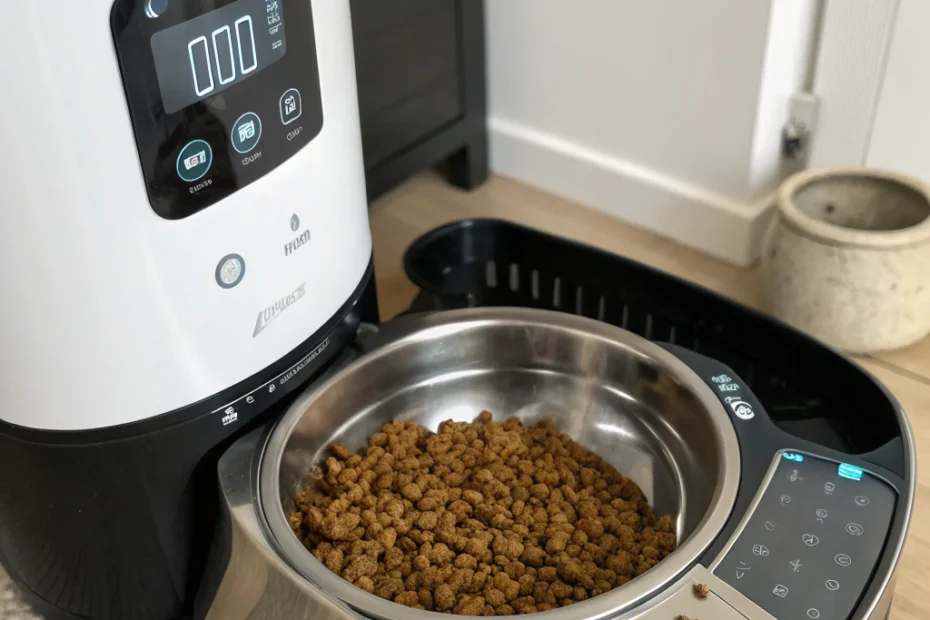At-a-Glance
Automatic pet feeders for cats are becoming increasingly popular among cat owners looking for convenience and consistency in feeding their feline friends. These devices may help ensure your cat receives the right amount of food at the right time, even when you’re not home. They can support your cat’s health by maintaining a regular feeding schedule, which is crucial for their well-being. In this guide, we’ll explore how to choose the best feeder, safety considerations, and more.
How to Choose
When selecting an automatic pet feeder for your cat, consider several factors to ensure it meets your needs and those of your pet. Here are some key points to think about:
Capacity and Portion Control
Choose a feeder with a capacity that matches your cat’s dietary needs. Some feeders allow you to set precise portion sizes, which can support weight management and prevent overfeeding.
Power Source
Automatic feeders can be powered by batteries, electricity, or both. A dual power option may provide peace of mind in case of a power outage.
Programmable Features
Look for feeders with programmable timers that let you set multiple feeding times throughout the day. This feature can be particularly useful if your cat requires frequent small meals.
Ease of Cleaning
Feeding dishes and storage compartments should be easy to clean to maintain hygiene. Some models offer dishwasher-safe components.
Material and Durability
Consider the material of the feeder. Stainless steel and BPA-free plastic are commonly used for their durability and safety.
Safety & Setup
Setting up your automatic pet feeder correctly is crucial for your cat’s safety and the device’s effectiveness. Here are some tips:
Read the Instructions
Always read the manufacturer’s instructions carefully before setting up the feeder. This ensures you understand how to operate it safely and effectively.
Secure Placement
Place the feeder on a stable, flat surface to prevent tipping. Ensure it’s in a location where your cat feels comfortable eating.
Test the Feeder
Before relying on the feeder, test it to make sure it dispenses the correct amount of food at the scheduled times.
Monitor Initial Use
When first using the feeder, monitor your cat’s response to ensure they are eating properly and the device is functioning as expected.
Core Pillars
The core pillars of using automatic pet feeders for cats include convenience, consistency, and control. These devices can simplify your life by automating feeding schedules, ensuring your cat receives meals at consistent times, and allowing you to control portion sizes easily.
Placement & Environment Tips
Where you place your automatic pet feeder can impact its effectiveness and your cat’s comfort. Consider these tips:
- Quiet Area: Place the feeder in a quiet area away from household noise to encourage your cat to eat calmly.
- Away from Litter Box: Keep the feeder away from the litter box to maintain hygiene and prevent your cat from associating food with waste.
- Accessible Location: Ensure the feeder is easily accessible to your cat but not in a high-traffic area where it could be disturbed.
Comparison with Alternatives
Automatic pet feeders offer several advantages over traditional feeding methods, but they may not be suitable for every cat or owner. Here’s how they compare:
Traditional Bowls
While traditional bowls are simple and inexpensive, they require manual feeding, which can be inconvenient for busy owners.
Interactive Feeders
Interactive feeders, such as puzzle feeders, can provide mental stimulation but may not offer the same level of portion control and scheduling as automatic feeders.
Manual Portion Control
Manual portion control requires more effort and consistency from the owner, which may not be feasible for everyone.
FAQs
Here are some common questions cat owners have about automatic pet feeders:
Can automatic feeders accommodate wet food?
Some models are designed for wet food, but they may require more frequent cleaning to prevent spoilage.
What if my cat is afraid of the feeder?
Introduce the feeder gradually, allowing your cat to explore it while it’s turned off. Positive reinforcement can help them adjust.
How do I know if the feeder is working properly?
Regularly check the feeder’s operation and monitor your cat’s eating habits to ensure it’s dispensing food correctly.
What to Do Next
Now that you have a better understanding of automatic pet feeders for cats, consider assessing your cat’s specific needs and lifestyle to determine if this technology is right for you. Research different models and features to find a feeder that aligns with your requirements. Remember, while these devices can offer convenience and support your cat’s health, they are not a substitute for regular interaction and care. Always keep an eye on your cat’s overall well-being and consult your veterinarian for personalized advice.
Disclaimer: Always consult your veterinarian for personalized advice regarding your cat’s health.
